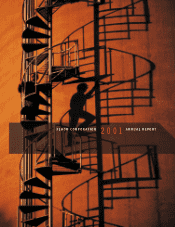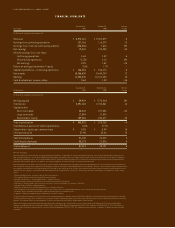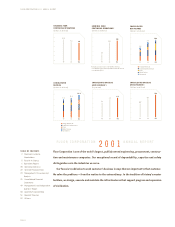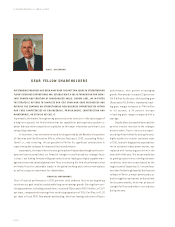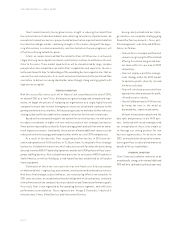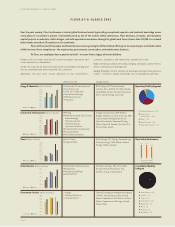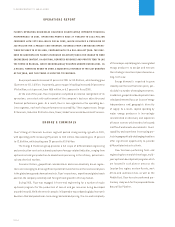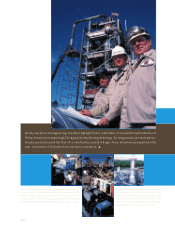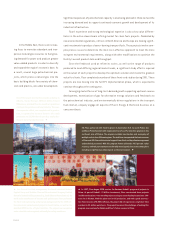Fluor 2001 Annual Report Download - page 10
Download and view the complete annual report
Please find page 10 of the 2001 Fluor annual report below. You can navigate through the pages in the report by either clicking on the pages listed below, or by using the keyword search tool below to find specific information within the annual report.
In the Middle East, there is an increas-
ing focus to monetize abundant and inex-
pensive natural gas resources to fuel grow-
ing demand for power and produce greater
value-added products in order to diversify
and expand the region’s economic base. As
a result, several large petrochemical pro-
jects, which process natural gas into the
basic building blocks for a variety of chem-
icals and plastics, are under development.
One of the largest construction projects underway in
Alberta, Suncor Energy’s CDN$3.4 billion Project
Millennium, provided Fluor its smoothest operations
startup in the petroleum refining industry. This mas-
sive expansion effort, now complete and in produc-
tion, is expected to increase Suncor's oils sands
production to 225,000 barrels per day, nearly dou-
bling its current production level. ▼
Significant expansion of petrochemical capacity is also being planned in China to meet the
increasing demand and to support continued economic growth and development of its
industrial infrastructure.
Fluor’s experience and strong technological expertise is also a key value differen-
tiator in the active downstream refining market for clean fuels projects. Mandated by
new environmental regulations, refiners in North America and Europe are making signifi-
cant investments to produce cleaner-burning transport fuels. These projects involve com-
plex process issues to determine the most cost-effective approach to meet the more
stringent environmental requirements, along with other modifications to optimize the
facility’s overall product slate and throughput.
Since the feedstock used at refineries varies, as well as the range of products
produced to meet differing regional market needs, a significant study effort is required
at the outset of each project to develop the optimum solution and create the greatest
value for clients. Fluor completed a number of these front-end studies during 2001. These
projects are now moving into the full EPC implementation phase, which is expected to
continue throughout the coming year.
Converging market forces of long-term demand growth supporting upstream reserve
development, monetization of gas for alternative energy solutions and feedstocks to
the petrochemical industry, and environmentally driven regulations in the transport
fuels market, uniquely engage all aspects of Fluor’s Energy & Chemicals business on a
concurrent basis.
ICA Fluor partnered with Stork Engineers & Contractors B.V. to assist Pemex Gas
and Basic Petrochemicals with implementation of a sulfur reduction program in the
southeast area of Mexico. The program included construction and revamping of
multiple units in four different regions. The task force incorporated the best resources
of Fluor and ICA Fluor with technical support from Stork and key client management
and technical personnel. With this program Pemex achieved a 98.5 percent sulfur
recovery, with tail gas treatment considerably reducing emissions to the atmosphere
including a significant positive impact on the environment. ▼
▲ In a first-of-its-kind arrangement, the Saudi Industrial Venture
Capital Group and Arabian Chevron Petrochemical Company Limited
formed a limited liability partnership, Saudi Chevron Petrochemical, for
world scale manufacture of benzene and cyclohexane. Fluor performed
the front-end engineering and program management for the $650 mil-
lion grassroots petrochemical project in Saudi Arabia, as well as the
detailed EPCM for the off-plot facilities. The project was completed
under schedule and recognized nationally for safety excellence.
▲ In 1997, Fluor began EPCM services for Eastman Kodak’s program of projects in
China. As part of Kodak’s $1 billion investment, Fluor constructed three projects
in different locations — two retrofit projects and a grassroots facility located on a 100-
acre site in Xiamen. With the plant now in full production, and with a peak construc-
tion force in excess of 5,000 craftsmen, the project did not experience a single lost-time
accident in 22 million work hours. The project team met the challenge of making this
program a cornerstone for Kodak and Fluor’s future success in China.
PAGE 8

